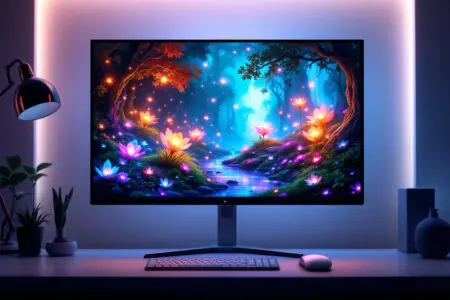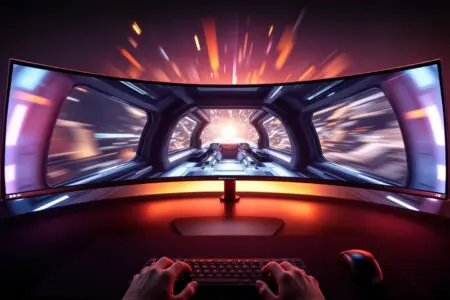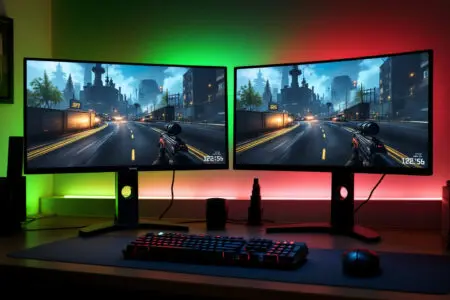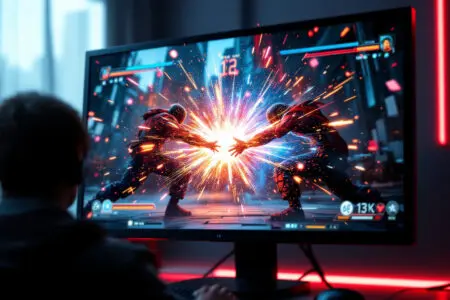You know the feeling. You walk into an electronics store, or you’re scrolling endlessly online, and your eyes just glaze over. It’s a tidal wave of acronyms and specs. 144Hz, 4K, HDR, G-Sync, FreeSync. Then you see it, a tiny number tucked away in the fine print: 1ms. 5ms. Maybe even 0.5ms. That, my friend, is response time.
It’s one of the most talked-about, yet completely misunderstood, specs in PC gaming. The marketing screams that faster is always better, that you need that 1ms spec to compete. But is that the whole story? As someone who has chased pixel-perfect performance for more years than I’d like to admit, I can tell you the answer is way more interesting. Understanding what is monitor response time is the first step to building a gaming rig that works for you, not for the marketing department. It’s about separating the hype from the reality of the hardware.
More in Monitors Category
Is a Curved Monitor Good for Gaming
Key Takeaways:
- Response time is simple: it’s how fast a single pixel on your screen can change its color. We measure it in milliseconds (ms).
- You’ll mostly see GTG (Gray-to-Gray), a spec heavily used in marketing. MPRT (Moving Picture Response Time) is a different tool for measuring motion blur, not raw pixel speed.
- A slow response time creates ugly visual problems like ghosting (blurry trails) and motion blur, which can wreck your immersion in fast-paced games.
- The right response time depends on your games. Competitive shooter fans will want that 1ms speed, but if you’re into slower-paced titles, 5ms or even a bit higher is perfectly fine.
- Your monitor’s panel type—TN, IPS, or VA—is a huge deal. It dictates the trade-off between speed, color quality, and contrast.
So, What Exactly Is This “Response Time” Everyone Talks About?
Let’s just get right to it. Monitor response time is all about speed. Not the whole monitor, though. It’s about the speed of its tiny building blocks: the pixels. Your screen is a massive grid of millions of little color-changing lights. For you to see anything, every single one has to show the right color at the right moment.
When the action happens—you whip your mouse around in Valorant or a car rockets past in Forza Horizon—those pixels have to change color. Instantly. Response time is just the measurement of how long that takes.
That’s the concept. Simple.
In practice, it’s a bit more complex. This speed is everything because if the pixels can’t keep up with the new frames your GPU is pumping out, you get some nasty visual glitches. It’s like a flipbook. If you flip the pages too fast, the drawings just blur together. A monitor with a slow response time is exactly like that.
How Is It Actually Measured?
The real-world process is super technical, using precise sensors and strict tests. Technicians measure the time it takes for a pixel’s brightness to change between different states. They don’t just check a pixel going from pure black to pure white. That’s an old, less useful measurement you might see called “BWB” (Black-to-White-to-Black).
Instead, the modern standard is Gray-to-Gray, or GTG. This test measures the transition time between two different shades of gray. This is far more realistic because in any game or video, most pixel changes are between different shades and colors, not just the absolute extremes. A GTG measurement gives you a much better idea of how the monitor will perform when you actually use it. So when you see that “1ms” advertised, it’s almost certainly the GTG response time.
Why Are We Talking in Milliseconds?
Using milliseconds (ms) just shows how insanely fast this all is. A millisecond is one-thousandth of a second. It’s a sliver of time so short you can’t even perceive it. But for a display, these tiny fractions of a second make all the difference.
Think about it. A 60Hz monitor shows you 60 new frames every single second. A quick bit of math (1000ms / 60) tells us each frame is on screen for about 16.67 milliseconds. If a pixel’s response time is 20ms, it physically cannot finish changing color before the next frame arrives. That overlap is what creates visual problems. On a 144Hz monitor, that window shrinks to just 6.94ms. For a 240Hz screen, it’s a wild 4.17ms. Suddenly, a 5ms or 1ms response time stops being a fancy number on a box and becomes absolutely essential for the monitor to keep up.
Aren’t There Different Ways to Measure Response Time?
Here’s where the marketing gets a little slippery. Just when you think you’ve got it figured out, you see manufacturers using different acronyms. GTG and MPRT are the big two. They measure completely different things. It’s not about one being “fake” and the other “real.” They just describe different parts of a monitor’s performance, and you need to know the difference.
It’s like comparing a car’s 0-60 time to its top speed. Both tell you about performance, but in very different ways.
What’s the Deal with GTG (Gray-to-Gray)?
As we covered, GTG is the industry standard for good reason. It’s the raw speed of the liquid crystals inside the pixels. It asks the question, “How fast can a pixel physically change state?” This number is what fights “ghosting,” that annoying faint trail left behind moving objects.
I remember my first “real” gaming monitor upgrade like it was yesterday. I was playing Counter-Strike on some ancient, cheap LCD. Every time I flicked my aim, the enemy models would smear, leaving these blurry trails. It was a nightmare for tracking targets. When I finally bought a proper gaming monitor with a low GTG time, the change was night and day. Everything was suddenly crisp and clear, even in a chaotic firefight. That’s what a good GTG time does. It provides the clean foundation for all motion.
And What About MPRT (Moving Picture Response Time)?
MPRT is a different animal. It doesn’t measure how fast a pixel changes. It asks, “For how long do I see a pixel as it moves?” This is all about measuring your perception of motion blur.
See, our eyes and brains create some motion blur naturally just by tracking things. Monitors add their own blur when a pixel stays lit for too long while it moves across the screen. To fight this, gaming monitors often use a backlight strobing technique, sold under names like ULMB (Ultra Low Motion Blur) or DyAc (Dynamic Accuracy). This feature flashes the backlight on and off in sync with the refresh rate.
This strobing shoves a black frame in between the real ones, which cuts down the time our eyes see a continuously lit pixel. The result is a much clearer moving picture. The trade-offs? You lose a lot of screen brightness, and you can’t use it with G-Sync or FreeSync. A “1ms MPRT” spec means the monitor is using this strobing trick.
Why Do Manufacturers Seem to Prefer One Over the Other?
Marketing. It’s that simple. GTG measures the panel’s raw, native speed. MPRT measures the effect of a specific feature. Getting a true 1ms GTG response time is really, really hard and usually requires expensive panel tech (like the latest TN or Fast IPS panels).
Getting a 1ms MPRT rating, however, is much easier to achieve on more panels using backlight strobing. This is why you’ll see a monitor advertised as “1ms” without being clear about which 1ms it is. If you see a 1ms monitor with a GTG time of 5-7ms, you can bet that 1ms is MPRT with the blur-reduction mode turned on. It’s not a lie, but it’s misleading if you don’t know what to look for. A true 1ms GTG monitor is always clear in motion. A 1ms MPRT monitor is only that clear when you enable a specific mode with all its drawbacks.
Can a Slow Response Time Really Ruin My Game?
Yes. Absolutely. But “ruin” means different things to different gamers. For a pro player, the tiniest visual hiccup can mean losing a match. For a casual gamer chilling in a beautiful RPG, it might not matter one bit. The impact of response time is all about what you’re doing.
This isn’t just about a number. It’s about the real, visible problems that a slow response time creates. These artifacts will break your immersion and can even make it harder to aim. The two biggest offenders are ghosting and motion blur.
Have You Ever Seen a “Ghost” on Your Screen?
Ghosting is the classic symptom of a slow response time. It looks like a smudgy, see-through trail following things that move on screen. The name is perfect, because it genuinely looks like a phantom is being dragged behind the object. This happens when the pixels don’t finish their color change from one frame to the next. The old image hasn’t faded away before the new one is drawn, creating a blended, blurry mess.
In a shooter, ghosting can make an enemy moving in a doorway look like an indistinct smear, making it tough to land a clean headshot. In a racing game, the background and other cars can look smudged and blurry. Some people are more sensitive to it than others, but once you notice it, you can’t ignore it.
Is Motion Blur the Same Thing?
Not exactly, but they’re related. Ghosting is that distinct trail. Motion blur is a more general loss of sharpness when things are moving. A slow response time is a huge cause of this. Think of it this way: ghosting is a specific symptom, and motion blur is the disease.
As we’ve discussed, our own eyes create some motion blur. That’s what MPRT and backlight strobing are meant to fix. But the blur caused by slow pixels (a bad GTG time) is a separate problem. You can have a monitor with amazing MPRT that still looks blurry if its GTG time is poor. For the clearest possible picture, you need a monitor that has both: fast pixels and good blur reduction.
What About Input Lag? Is That Connected?
This is a huge point of confusion. Let’s clear it up: Response time is not input lag. They are two totally different things.
- Response Time: How fast a pixel changes color. (Purely a visual thing on the screen).
- Input Lag (Latency): The total delay from your action (clicking your mouse) to the result appearing on screen.
Input lag is a full-system delay. It includes the processing time of your mouse, your PC, and your monitor’s internal electronics. A gaming monitor with a fast response time usually has low input lag because it’s built for speed, but it’s not a given. You could have a 1ms response time monitor with terrible input lag from slow processing. For gamers, low input lag is arguably even more important than response time, as it dictates how connected you feel to the game.
What Kind of Response Time Should I Actually Look For?
There’s no single “best” response time for every person. The search for the perfect monitor is about balancing features for your needs and budget. A competitive Counter-Strike player has totally different needs than someone raiding in Final Fantasy XIV. Buying a top-tier 360Hz, 1ms monitor to play Civilization VI is just wasting money. Trying to play Apex Legends on a 60Hz office monitor with a 20ms response time will only lead to pain.
Be honest about what you play.
Does Every Gamer Need a 1ms Monitor?
No. Definitely not. The obsession with the 1ms number is mostly just good marketing. While 1ms is objectively the sharpest in motion, the visible difference between 1ms and 4ms can be very hard to spot for most people. Many amazing IPS gaming monitors, with their far superior colors and viewing angles, have a 3-5ms GTG response time, and they offer a fantastic gaming experience.
This is a classic case of diminishing returns. The leap from a 15ms monitor to a 5ms one is huge and obvious. The jump from 5ms to 1ms is much, much smaller. Don’t let anyone tell you that a monitor over 1ms is “slow.” It’s simply not true.
What’s a Good Response Time for Competitive Shooters like Valorant or Apex?
This is the one category where response time matters most. In these games, targets are small, move fast, and are only visible for a split second. Maximum motion clarity gives you a real competitive edge. It helps you track targets more smoothly, spot enemies against cluttered backgrounds, and react faster.
For this kind of gaming, go for the lowest true GTG response time you can find, ideally 1ms to 3ms. This is where the esports-grade monitors live. Paired with a high refresh rate (240Hz or higher), this level of responsiveness gives you the razor-sharp image you need to compete. Every millisecond truly does count.
What if I Just Play RPGs and Strategy Games?
If your library is full of titles like The Witcher 3, Baldur’s Gate 3, or Age of Empires IV, the need for blistering speed plummets. In these games, you want amazing visuals, accurate colors, and immersive details more than raw speed. You’re not trying to track a tiny target; you’re admiring a gorgeous landscape.
For these genres, a response time in the 4ms to 8ms GTG range will feel great. You’d be better off spending your money on an IPS or VA panel for better colors and contrast than chasing a 1ms spec on a TN panel. The world will look more beautiful and immersive, and you’ll never notice any ghosting.
How Does My Monitor’s Panel Type Affect Response Time?
The technology inside your monitor—the panel type—is the biggest factor that determines how it performs. The three main LCD types are TN, IPS, and VA. Each one is a different compromise between speed, color, and contrast. It’s like picking a class in an RPG: you can’t be the best at everything, so you have to pick what’s most important to you. For a deeper technical dive, academic resources from places like the University of Cambridge’s engineering department can provide incredible insight into the actual physics at play.
Are TN (Twisted Nematic) Panels the Fastest?
Yes, TN panels are the speed demons. They have a simple liquid crystal structure that lets them change state incredibly quickly. For years, this was why all the top-tier 1ms gaming monitors were TN. If your only goal is the absolute fastest response time for a competitive advantage, TN is still a great option.
But that speed comes at a price. TN panels have the worst color reproduction of the three. Colors can look washed out and bland compared to IPS or VA. They also have terrible viewing angles. If you’re not looking at it straight-on, the colors and contrast shift dramatically. This isn’t a huge problem for a gamer sitting right in front, but it’s annoying for anything else.
What Are the Benefits of IPS (In-Plane Switching) Panels?
IPS panels are the best all-rounders. Their biggest strength is stunning color accuracy and consistency. An IPS monitor will show you vibrant, rich, and true-to-life colors that look great from almost any angle. This makes them a favorite for creative professionals and anyone who loves good-looking graphics.
For a long time, IPS was considered “slow.” Early versions had high response times that made them bad for gaming. But the technology has come a long way. Modern “Fast IPS” panels can now hit true 1-3ms GTG response times. They give you the best of both worlds: elite speed and gorgeous colors. This has made them the most popular choice for high-end gaming monitors. Their main weakness is a lower contrast ratio than VA panels, so blacks can sometimes look a bit gray in a dark room.
Where Do VA (Vertical Alignment) Panels Fit In?
VA panels are the kings of contrast. They are exceptionally good at blocking the monitor’s backlight, which lets them produce deep, inky blacks. A VA panel can have a contrast ratio of 3000:1 or more, which blows away the 1000:1 you usually see on IPS and TN panels. This makes them amazing for playing games or watching movies in a dark room; the extra image depth is very noticeable.
The historic weakness of VA panels has always been response time, especially with dark colors. This can cause “black smearing,” a noticeable ghosting on dark objects. Like IPS, however, VA tech has improved. Modern VA panels are much better, though they still can’t quite match the motion clarity of the best Fast IPS or TN panels in the most extreme cases. They’re a great middle ground for gamers who want an immersive, high-contrast experience and play a variety of games.
I’ve Heard of Something Called “Overdrive.” What Does It Do?
If you dig into your monitor’s settings, you’ll find an option called “Overdrive,” “Trace Free,” or just “Response Time.” This is a powerful tool, but it can cause problems if you just crank it up without understanding it. It’s not a magic “go faster” button. It’s a fine-tuning control that needs a careful touch.
I learned this the hard way. I got a new monitor and immediately went into the settings and set everything to the max, just like any gamer would. I put Overdrive on its highest “Extreme” setting. The result was a mess. Instead of blurry ghosts, I was now seeing these weird, bright halos on the edge of moving objects. It was even more distracting. That’s when I learned that with Overdrive, max settings are not always better.
Is This Like Overclocking My Monitor?
That’s a great way to think about it. Overdrive pushes more voltage to the pixels to make them change color faster than they normally would. This is how manufacturers get a panel to hit that advertised response time. A panel that might naturally be 7ms can be pushed to 4ms or less with good Overdrive.
Almost every gaming monitor uses Overdrive. The different settings (Low, Medium, High) just control how much extra voltage is used. A lower setting is safer but has less effect, while a higher setting is more aggressive.
Can Cranking Up Overdrive Cause Problems?
Yes. The problem is called overshoot, or inverse ghosting. That’s what I saw when I used the “Extreme” setting. When the Overdrive voltage is too high, it makes the pixels “overshoot” their target color. For example, a pixel trying to change from dark gray to light gray might flash to a brighter white for a split second before settling down.
This looks like a bright or strangely colored trail following an object, the opposite of normal ghosting. It can be just as distracting. The goal is to find the highest Overdrive setting that works well without causing noticeable overshoot. This “sweet spot” is usually the medium or second-highest setting, but it varies between monitors and can even change based on your refresh rate.
So, When I’m Shopping, What’s More Important: Refresh Rate or Response Time?
This is the ultimate monitor question. But the truth is, they’re not competing specs. They are two parts of the same whole. You need both to be good to get a clear, responsive gaming experience. Aence. Having a higher in o totally crippledy bottlenecked by a low number in t have tohe ot together.
Think of a sports car. The refresh rate is its top speed. The response time is its acceleration. Ae is decelerate. Having a car that can go 200 m a minute to get there. A car that accelerates like a rocket is less fun if it tops out at is less impressive if need both h drive. It’s the same with monitors.
How Do They Work Together?
Refresh rate (in Hz) is how manyhey Work Togetherfresh rate ( drawsf times per second that the monitor re how longdrawth a ne takew i make that change. For the picture to be clear, the pixel response time must be faster than the time between refreshes.
Like we figured out earlier, a 144Hz monitor gives pixels just under 7ms to change. If yourext refres begins.
As we calcula you’ll get a blurry, ghosty image because the pixels are always one step behind. They’re still tryingme drawis 10ms, you’re going to get a blurry, sent. That completely ruins the smoothness you paid for with that high refresh rate.
If I Have a High Refresh Rate, Do I Need a Fast Response Time?
Yes. One hundred percent.image that completely negmoothness benefit of th criticalresh rate.
If I Have a High Refresh Rate, Do I Need a Fast Response Time?
Yes, unequivocally. In fact, the higher your monitor’s refresh rate, the more important a fast response time becomes. At 60Hz, a 10ms response time might be noticeable but manageable. At 240Hz, that same 10ms response time would make the monitor virtually unusable for its intended purpose. The window of time for pixels to change gets smaller and smaller as refresh rates climb, putting immense pressure on the panel’s response time to keep up.
This is why you can’t just look at one number. A 240Hz monitor with a slow response time is a poorly balanced product. A great gaming monitor has a response time that is well-matched to its refresh rate, ensuring that you get the full benefit of that fluid, high-frame-rate image. This synergy is the true secret to motion clarity.
The Final Verdict: Does It Really Matter?
After all this, we come back to the original question. What is monitor response time, and does it matter for gaming? Yes, it matters. It matters a lot. It’s a fundamental component of your monitor’s ability to display a clear, sharp, and artifact-free image during motion.
But its importance to you is personal. It’s a crucial thread in the complex tapestry of monitor performance, woven together with refresh rate, panel type, color accuracy, and input lag. Don’t fall for the marketing hype that tells you a single number is the only thing that matters. Instead, arm yourself with knowledge. Understand what you play, what you value in a visual experience, and what trade-offs you’re willing to make. For some, the absolute pinnacle of speed is worth any compromise. For others, a vibrant, beautiful world is more important than a few milliseconds. There is no right answer, only the right answer for you.
FAQ – What is Monitor Response Time

How do response time and refresh rate work together in a monitor?
Both are essential for smooth motion; high refresh rates provide more frames per second, while fast response times ensure pixels can keep up with these frames without blurring, creating a clear and responsive image during gaming.
What response time should I look for in a gaming monitor?
For competitive shooters like Valorant or Apex, aim for a monitor with a true GTG response time of 1 to 3 milliseconds. For less fast-paced games, a response time of 4 to 8 milliseconds is generally sufficient.
Can a slow response time ruin my gaming experience?
Yes, slow response times can cause ghosting, motion blur, and other visual glitches that disrupt immersion and make aiming or tracking targets difficult, especially in fast-paced competitive games.
How is monitor response time measured, and what do terms like GTG and MPRT mean?
Response time is measured in milliseconds and typically using GTG (Gray-to-Gray), which indicates how fast pixels transition between shades of gray. MPRT (Moving Picture Response Time), on the other hand, measures how long a pixel remains visible and is used to assess motion blur reduction features.





